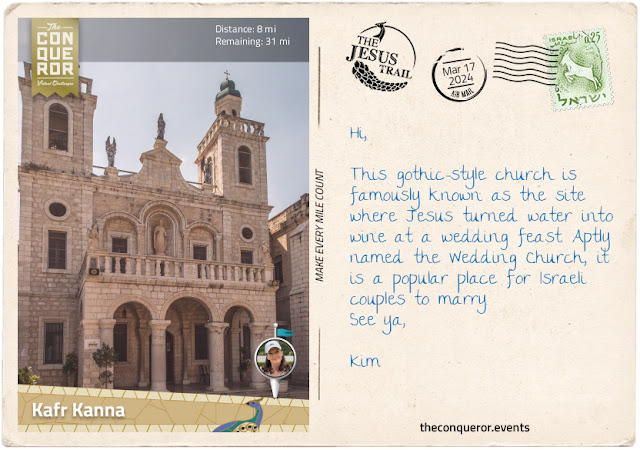Having left Nazareth, I hiked northwest to Zippori National Park, an archeological site and home to the ancient city of Zippori. It was inhabited from the Hellenistic period (circa 323 BC to 31 BC) until the Arab conquest in the 7th century. The site contains a beautifully preserved Roman amphitheater, the ruins of a Crusader fortress and synagogue, and several intricate mosaic designs. Zippori was a significant Jewish hub for learning, and it's where Rabbi Yehuda Hanassi compiled his life work called the Mishnah, the oral tradition of Jewish law.
After exploring the park, I connected with the Israel National Trail, a long-distance trek that spans the entire length of Israel from north to south. The two trails intersect at several points, making it easy to switch between paths if needed.
As I continued on the Jesus Trail, I came across the quaint village of Mash'had, inhabited by a fascinating minority group known as the Druze, with traditions dating back to the 11th century. Their faith incorporates elements from a variety of beliefs and philosophies, emphasizing the importance of the mind and the value of honesty. Although they honour several prophets, like Jesus and Mohammed, the Druze also hold the Greek philosophers Aristotle, Plato, and Socrates, and the Macedonian king Alexander the Great in high regard. This unique blend of faith and philosophy gives the Druze a distinctive and mysterious nature.
Less than a mile further (1.6km), I arrived in the small Arab village of Kafr Kanna. In ancient times it was identified as Cana and associated with the biblical story of Jesus turning water into wine at a wedding. The story goes that the wedding hosts ran out of wine, and Mary asked Jesus to help. So, Jesus asked the servants to fill six large stone jars with water which he then turned into wine. This transformation of water to wine was the first miracle attributed to Jesus. The site where it took place is now the location of the Wedding Church, a Franciscan church built in the late 1800s.
The church is built in a gothic style with a white façade and decorated with sculptures of angels. It has two levels, with the lower section serving as a museum containing artifacts from Jesus' time, including a jar believed to have been used to convert water into wine. On the upper level is a beautifully detailed portion of a Byzantine mosaic dating back to the 5th or 6th century discovered during excavations below the church. The mosaic includes an Aramaic dedication to the patron who commissioned it. Built on layers of history, the church is a connection to Jesus and ancient times.
Feeling like satisfying a sweet tooth, I looked for a place to indulge in a slice of Kanafeh, a Middle Eastern cheese and phyllo dessert. This delicious dessert is made of crunchy shredded phyllo drenched in floral and orange syrup, wrapped around a gooey cheese, and topped with chopped, toasted pistachios. Finger licking good. I finished this delight with a strong coffee powering me up for the next stage.










No comments:
Post a Comment
It's so good to see you here . . .